You are probably reading the art of tracking a wounded deer on your phone in the woods—so let’s get right to the point.
First, take a seat and relax. You have some reading to do, and you must stop chasing that deer further into the woods. With any luck, your deer is within 100 yards of you. Give it time, let it pass, and you might be done before dark.
Second, stop blaming yourself for the quality of your shot. Instead, give yourself some credit for being a determined and ethical hunter. Your commitment to finding this wounded deer says more about you as a hunter than any trophy hanging on your wall.
Let’s get started.
Related: How to plant a deer food plot.
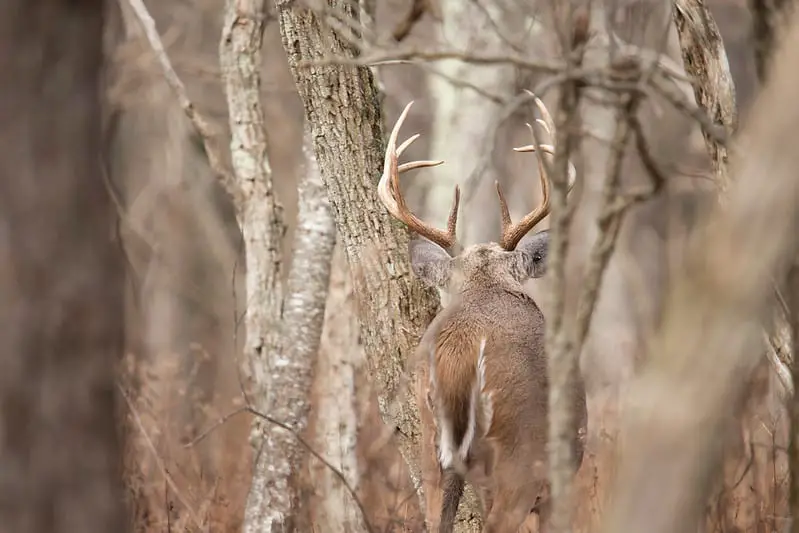
The art of tracking a wounded deer.
Tracking a wounded deer begins by collecting all the evidence—sound the weapon made hitting the target and damage to the arrow (bow), deer’s immediate reaction to the hit (bow/gun), examination of impact sight, color of the blood, splatter pattern on the trail, and sounds the deer made escaping.
You are about to search for a well-camouflaged animal in the woods. Every ounce of your attention will be devoted to your task. But you must first ensure your safety. Right now, call your safety contact, explain what you will be doing, where you are, and when you will report back to them.
If you have cell service, use an app or map and start tracking and updating your position. If darkness is approaching, it is safer to wait until morning. If you have flagging tape, prepare it to blaze the trail you’ll be making. Keep your hunter safety orange on during the entire search. Search safely, search slowly, and keep your safety glasses on.
This is an excellent place to take about some of the ”Rules of Thumb” for wounded deer. It is not always true that wounded deer never travel uphill, head for water, down deer are dead, or that your dog will find a wounded deer. Wounded deer travel to known areas of safety, dead deer kill or injure hunters yearly, and my dog is 50-50 o finding deer or ruining the track.
Related: The best hours of the day for deer hunting.
Related: Avoid these four common deer hunting mistakes.
Finding a wounded deer: The first 15 seconds.
Sound of the hit: The archer’s advantage when searching for a wounded deer.
An archer will often get two clues a rifle hunter doesn’t; the sound the arrow made entering the target and the evidence from the retrieved arrow.
The sound an arrow makes is the fastest fading evidence a deer detective will use. Like a blood light, you’ll either have it, or you won’t. If you heard the sound, it may tell you whether you have short or a long chase.
An arrow’s sound hitting a deer can hint at the location on the body that it struck. A crack like a bat hitting a baseball: Rib cage. Hollow thud sound: heart/lung area. A thunk sound, like an ax thrown into a tree: Shoulder hit. Warning: Arrow sounds are not an exact science.
Chest and Gutshot sounds that strike no bones upon entering are often similar to shooting a watermelon or pumpkin. Some archers have noted the ”whoosh” sound of escaping air from belly shots. Other archers have heard the metallic click of expandable broadheads opening when their shots enter a deer’s cavity.
Ribs hit by arrows make loud cracks. Heavier bones, like shoulders, sound much like an ax sunk into a tree trunk.
The problem with using sound is that the information is highly perishable. Your adrenaline will burn this memory within seconds. Even for those who recall the sound as a crystal clear memory, something gets lost in the translation when passing on an accurate sound description.
Related: Where to shoot a deer, deer shot placement.
Related: Do deer scents and covers really work?
The deer’s immediate reaction to your shot.
Whether you hit or miss, the deer is going to react. Study these fleeting seconds and look for these clues.
Wounded deer react according to the area of the body hit. Liver or gut shot deer run or walk a few yards, halt, and then struggle away with a hanging head and hunched back. Heart and lung hit deer kick their rear legs (or jump into the air) and then run off. Wounded deer often flee with tails down.
A Dead Right There (DRT) shot is not as common as we’d like to believe. Most deer travel a few yards, often just enough to drop into thick cover. Study the deer’s reactions until the moment it disappears.
Note the direction it takes and record the compass heading. Use a compass; even the one on your phone will work. Using the sun will only help if your search is a short one.
Watch how the deer flees. Does it walk or run? Does it stop and then appear to move again with difficulty and a hunched back (stomach shot)? Did it leap into the air and kick its rear feet backward (heart/lung shot)?
Does it visibly crumple to the ground some distance away (skip to the steps on approaching a wounded deer)?
Keep listening as the deer moves out of sight. If the sound suddenly stops, the deer may be bedding down. A liver-damaged deer will lay down with its head held up. This deer will need a finishing shot. The sound of a deer crashing to the ground is a mix of breaking branches, snapping twigs, and the impact of a heavy body thumping to the ground. If you hear this, skip to how to approach a wounded deer. If the sound gradually fades away, prepare for a long tracking job.
Related: The three best deer hunting calibers.
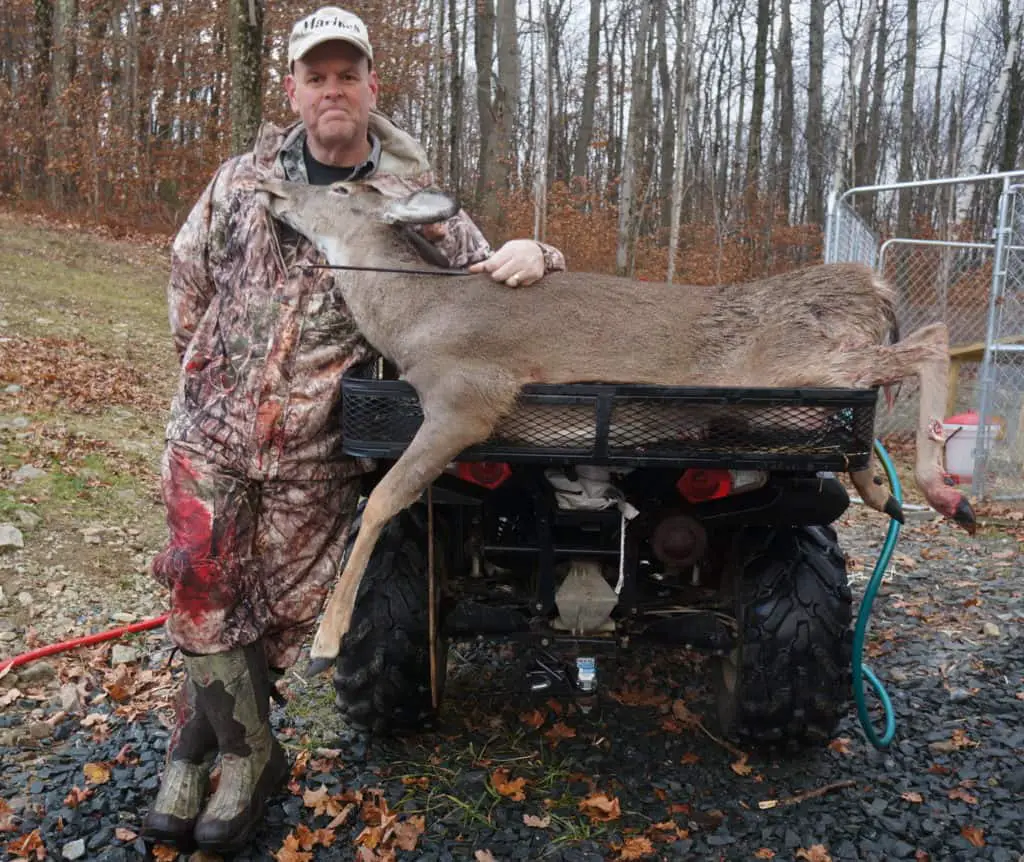
Tracking wounded deer: The next 10 minutes.
Archer’s advantage: Using the arrow to gauge where you hit the deer.
If you retrieve your arrow, whether it is broken or bloodied is valuable evidence.
Arrow damage provides evidence of penetration depth and the body area struck. Leg bones: Broken arrow, little to no penetration or blood. Rear (Ham): Broken arrow with varying penetration depths and blood. Neck: Broken arrow with bright red blood. Shoulder/spine: Broken arrow with little blood.
After your shot, an archer should spend the time to find and retrieve their arrow. Examine your arrow for damage to the broadhead, blood, hair, or grease on the shaft and fletches.
Broadhead damage can be tricky; it may have been done when impacting a bone or when it buried itself in the ground. If the arrow is coated with a greasy white material (fat) but no blood, this usually means a superficial wound on the back or chest. Heart and lung shots often cover the shaft in bright-red blood and abdomen shots in dark red.
Reading a broken arrow.
A broken arrow, one that did not pass through the deer can tell you how far your shot penetrated the deer and where it hit.
Broken arrows that hit a deer in the neck can sever the jugular (incredible and short blood trail), damage the spinal cord (instant paralysis), or a wound that results in a long and fruitless track. The blood on the shaft will be bright red up to the depth penetrated.
A hit in a shoulder can snap an arrow’s shaft, stop it before it does any harmful penetration, and leave little blood evidence behind. The only real clue you might find is blood sprayed chest high on tree trunks, leaves, and branches.
Spine hits do not always result in permanent paralysis (something I learned the hard way). If the deer recovers and bolts, you’ll be left with nothing more than a broken arrow and almost no blood trail to follow. For this reason, always take another shot on any likely spine-shot deer.
An arrow striking a leg will break and leave a small blood trail. If you know you have injured a deer’s leg, you can’t leave it for the coyotes to track down and finish off. You took a lousy shot, now do the right thing and find and reshoot that deer.
If you took a shot at the south end of a northbound deer, you might have struck in the leg, the hind quarters, the guts, or even scored a fatal heart wound. However, if you hit the rear quarters, your arrow will be broken and painted with bright red blood. Depending on the amount of blood left behind (often quite a bit and fatal if an artery has been cut, but quickly trailing off if not), you may have a long track ahead of you.
Related: Is deer hunting in the rain worth it?
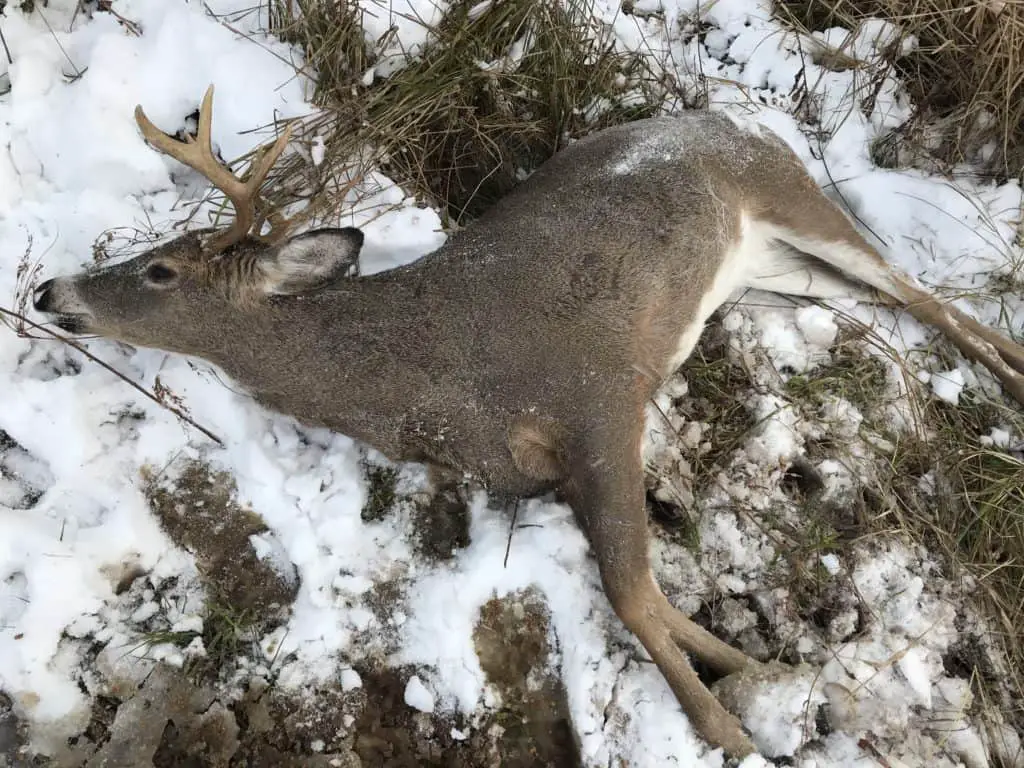
Examine the shooting site before tracking an injured deer.
The scene of the crime is where all great detectives begin their investigations.
When tracking wounded deer, you should note the deer’s reaction and the compass heading it fled in. Examine the site of the shooting for blood, flesh, or hair and any dew marks or existing trails. Use orange flags or tape to mark your progress. Search in a circular pattern to regain a lost track.
If you didn’t hear the sound or catch the deer’s reaction (we’ve all zoomed in so close the scope lost the deer in its sights as we pulled the trigger), the shooting location is where you will collect your first clues.
Now, think like a good television detective. What is their first complaint about a crime scene? That’s right, some rookie walked through it and disturbed the evidence. Begin your investigation from well outside the area. Get that phone camera going like paparazzi at a celebrity fist fight.
Keep your search as quiet as possible. You should look for hairs and blood on the ground and arrows or bullets in tree trucks. Arrows and bullet holes in trees or scuffed-up rocks in obviously wrong places can confirm a miss. Remember, your target may be wounded and bedded down only a few yards away.
Related: What is the best wind speed for deer hunting?
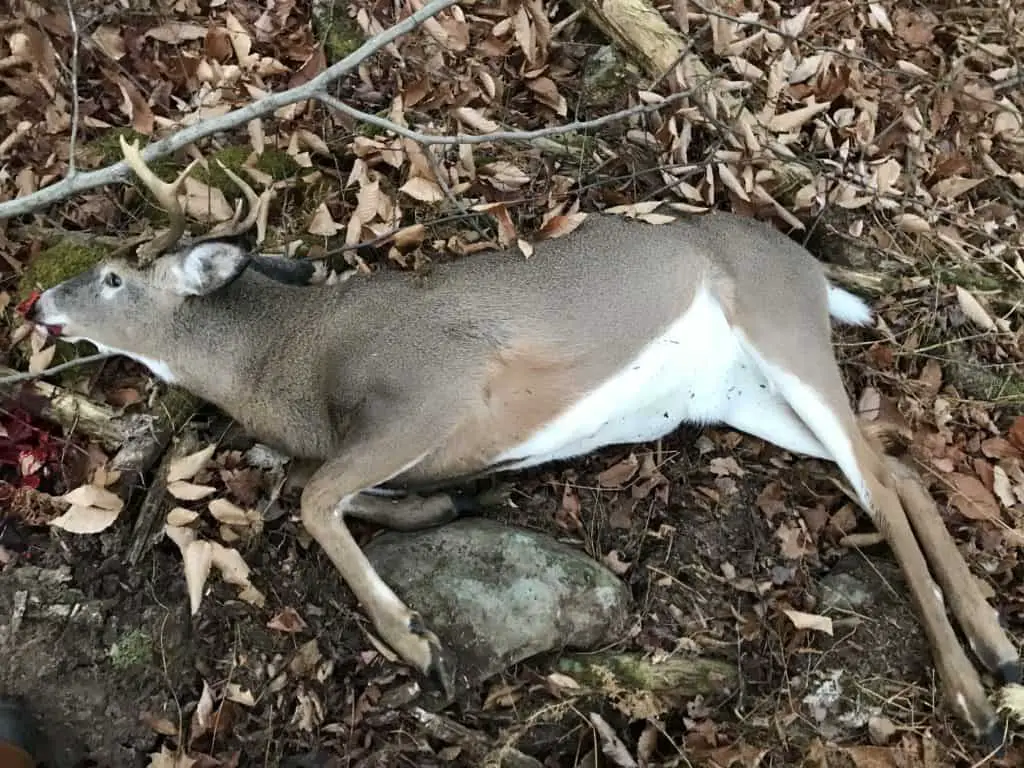
How long do you wait to be tracking a wounded deer?
One of the sorest tests you will take is dousing the fire inside you to start searching for a wounded deer instantly. If you fail the test, at best, you will significantly lengthen the time it takes. At worst, you will push an injured deer into an uncrossable property line or too far away to recover.
How long to wait before pursuing a wounded deer depends on the amount and color of blood (location of hit) left behind. Bright red blood in large amounts: 15-30 minutes (slow, silent stalk). Bubbly, bright-red blood: Wait an hour. Dark, red blood: Wait 4-6 hours. Greenish blood: eight-12 hours.
The color of the blood you find is your first solid clue to help you determine how long to wait. Blood color will tell you where and how badly the deer is injured.
Bright pink blood with bubbles means you have hit your deer in the heart and lungs. If you proceed will all stealth, you can start in 15-30 minutes. If you move like a pregnant yak, wait at least an hour.
Really dark-colored blood is the sign of a liver shot. This is lethal to the deer, but for at least 4-6 hours, the deer could be jumped and pushed further away. Wait those 4-6 hours and let the deer pass closer to your location.
Greenish or brown blood means you have hit the deer’s stomach. While the deer could take up to a day to die, the pain should cause it to bed down when it finds suitable cover. At a minimum, wait 8-12 hours, more if possible.
Related: Aging deer tracks.
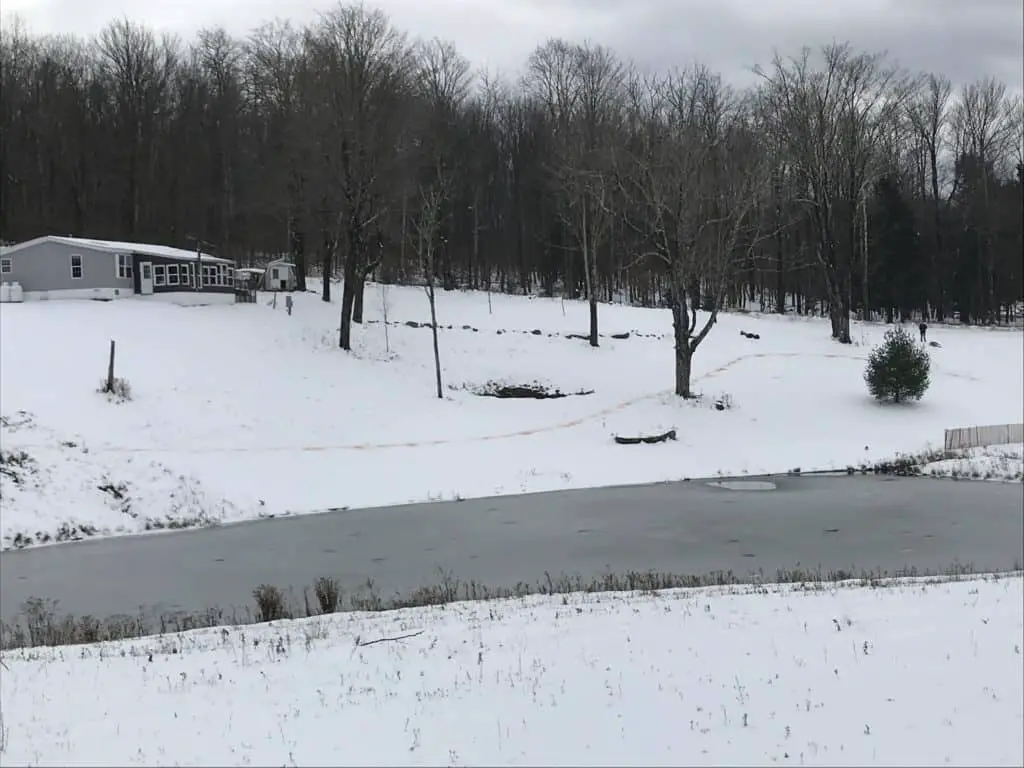
How far can a wounded deer travel.
Any estimate of the potential travel distance of a wounded deer is just that, an estimate. The exact distances are impossible without knowing various factors (did your arrow’s mechanical tip deploy, how large are the exit and entry wounds, etc.). Having said all that, there are some averages you can use.
How far a wounded deer will travel depends on where it was hit, the cover available, and whether or not it is being pursued. Heart shot, 100-300 yards. Lung shot, 100-300 yards. Liver shot, 500 yards to a couple of miles (delay pursuit). Gut shots, several miles (delay pursuit).
Heart and lung shot deer will travel about 100 yards, but often they topple over much closer to the shooting location. If the deer just exhaled and cannot inhale and its heart has stopped pumping blood, there’s nothing left in the engine room to move it forward.
If just the heart or both lungs are hit, a deer can make it 150 yards, and usually do.
Liver shot deer have 4-6 hours of movement left to them before they die. To get them to drop closer, let them find the first available cover and wait them out. If pressed, this can result in nearly 500 yards of slow, painful walking for them and you.
Gutshot deer can take forever to die. They can travel for miles with this injury.
If a single lung has been damaged, the deer will tear out of the danger zone at high speed, clear its six, and then start walking. If you bump it, there’s no telling how far that deer will get.
Related: Buck snorts and flagging tails, what do they mean?
Tips for tracking a wounded deer.
Flag the trees to clearly outline the track you have found and the direction you are moving in.
Stay off to the side of the trail. You want to preserve evidence, just in case the trail goes cold and you need to reexamine it.
Keep your shooting glasses on. If I only has a dollar for every time I got stabbed in the eye when standing back up.
If you lose the trail, start a small spiral and slowly work your way away from the last sign in ever expanding circles.
Take lots of breaks. Frustration and tiredness will coax you into quitting too early.
If you believe you may spook a wounded deer, back off and wait for as long as possible.
If you have to quit, come back with a friends, a blood tracker light, or a thermal device.
If you need additional help, find out if your state has deer tracking service like this one in Western New York.
Related: Deer feed and how to bait deer.
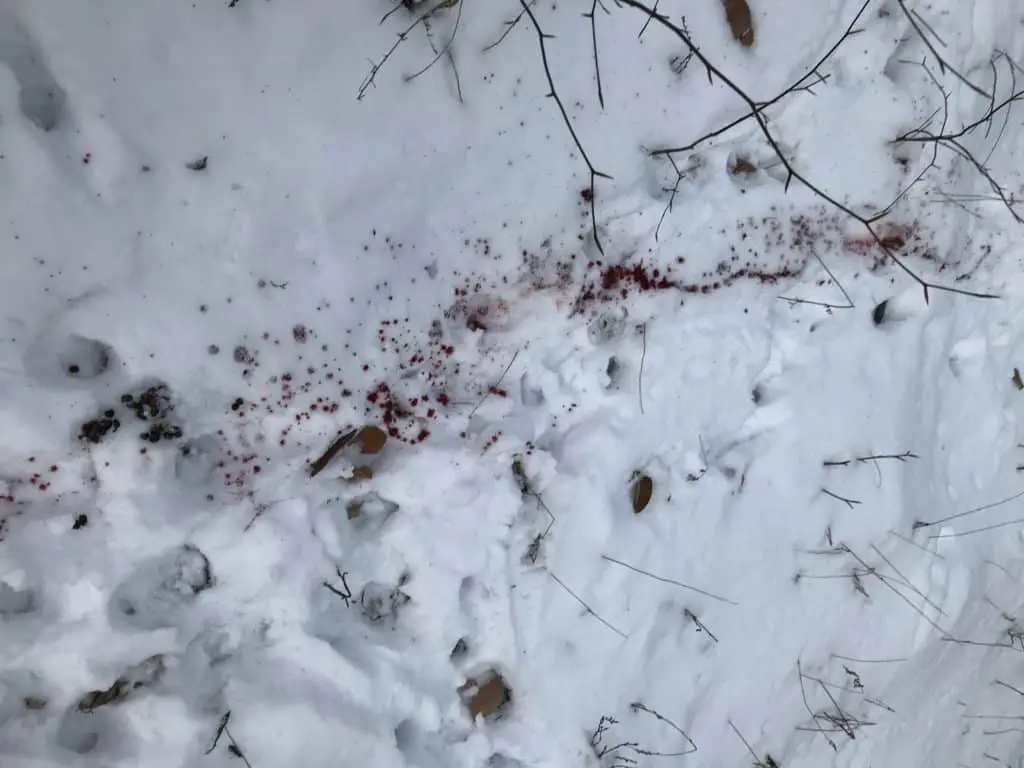
Using a blood trail to find a wounded deer.
Reading the blood splatter pattern of a wounded deer is shockingly easy, once you learn a few tips.
The blood pattern of a wounded deer provides valuable information. Slowly walking deer leave fat, circular drops of blood. Blood drops with narrow tails point in the direction of movement; the longer and thinner they are, the faster the deer moved. Wavy trails indicate the deer will soon die.
Blood found high (above your chest) on trees come from wounds high on the deer (like the back). Ropes and fans of blood painted across tree trunks, leaves, and other vegetation come from arterial sprays; they are easy to follow and result in short searches.
Blood drops that fall in flat circles are made by deer that stopped for a while. They listened, checked behind them, and may have looked around for enough cover to bed down in.
Speed and direction of blood drops on leaves and dirt are often your only clues if you are not tracking on snow or mud. Drops made by moving deer will have a tail that narrows and points in the direction of movement. The longer the tail of the blood dropped, the faster the deer moved.
Related: My buck is a doe?
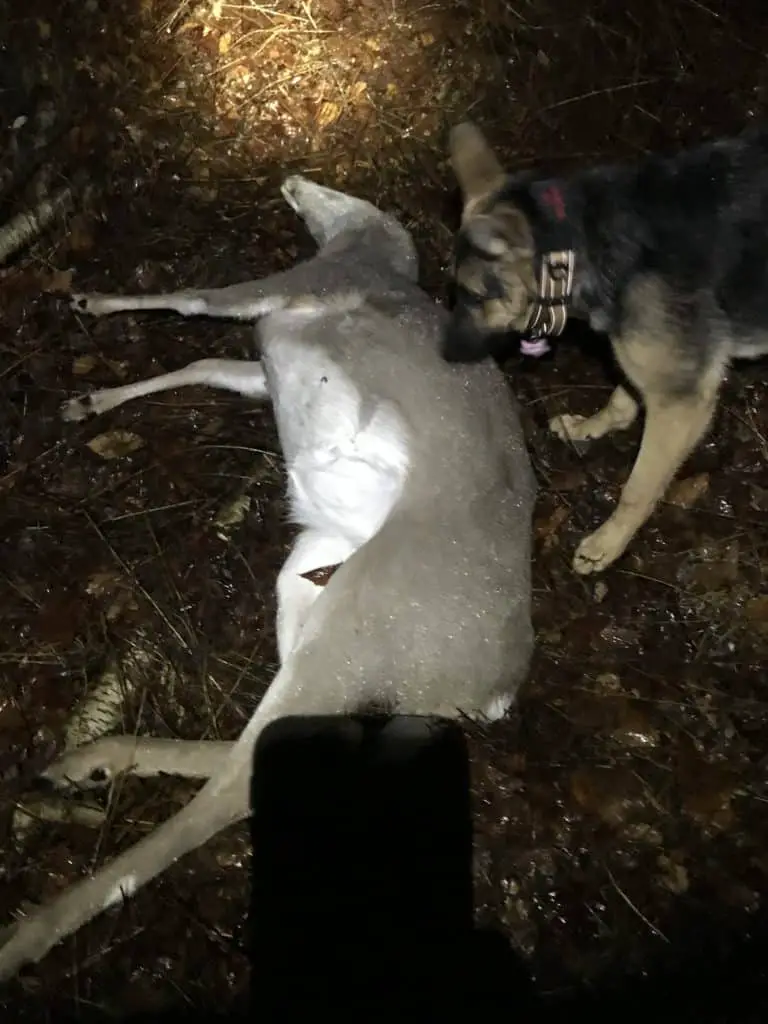
Be careful approaching an injured deer.
The worst way to end a day tracking a wounded deer is to get injured or killed by it. What may appear to be a dead buck and pop up and gore you. It could also kick your head open with its razor-sharp hoofs.
When approaching a wounded deer, exercise extreme caution. Upon discovery, stop and watch the deer for several minutes to determine if it is still breathing. Make your approach from the back of the deer to avoid being kicked. Dead deer have open eyes that don’t blink when touched by a stick.
When you spot the deer you have been tracking, get ready to fire a firing shot. Now, watch the deer for at least five minutes. Watch to see if the chest is rising and falling. If it is, send it another shot.
Once you are sure, it is no longer breathing, start your approach slowly and from behind. Use a long branch, and from a safe distance, tap the deer’s eyes with it. If the deer is dead, the eye will not blink when touched.
Related: My deer has warts!
Finishing off a wounded deer.
If the eyes are open or respond to touch, finish the deer off with another shot.
Finish off a deer you have wounded by either shooting it at the base of the ear or, if you wish to save the head for a mount, fire your shot into the heart/lungs. If bow hunting, always aim for the heart/lungs.
The sometimes hard job of tracking and finding a wounded deer is rewarding in two ways. First, you now know the value of taking a perfectly timed and placed shot. Second, you will have proven to yourself (win or lose) that you have the will needed to be an ethical hunter.
Better luck next season!
Related: Do car deer whistles really work?


